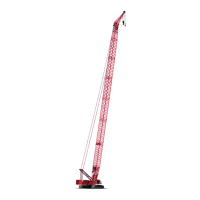POWER TRAIN 16000 SERVICE/MAINTENANCE MANUAL
7-20
Published 05-03-17, Control # 228-03
DPF/DOC MODULE OPERATION AND
SERVICE
The Diesel Particulate Filter / Diesel Oxidation Catalyst
(DPF/DOC) module (Figure 7-14
) is the first stage of the
diesel exhaust after treatment system. It incorporates a NO
x
(nitrogen oxide) sensor, a dual pressure (dP) sensor, and
two temperature sensors.
The Diesel Oxidation Catalyst (DOC) portion of the module is
the inlet end of the module. The DOC oxidizes remaining
hydrocarbons in the exhaust to carbon dioxide.
The DPF portion of the module is the outlet end of the
module. The DPF captures soot and ash:
• Soot is partially burned fuel particles that occur during
normal operation (black smoke). Soot is automatically
removed by a process called regeneration.
• Ash is partially burned engine oil particles that occur
during normal operation. The remaining ash is captured
and must be removed at periodic intervals. See the
Maintenance topic later in this document for more
information.
Regeneration
Regeneration is the process of converting the soot collected
in the DPF into carbon dioxide. Regeneration requires heat.
Two types of regeneration are used: passive and active.
Passive Regeneration
Passive regeneration occurs when the exhaust tempera-
tures are naturally high enough to oxidize the soot faster
than it is collected in the DPF.
The process typically occurs during normal crane operation.
The operator will not know when passive regeneration is
occurring.
Active Regeneration
Active regeneration occurs when the exhaust temperatures
are not naturally high enough to oxidize the soot faster than it
is collected in the DPF. If this happens, the engine controller
will initiate the process (see the engine manufacturer’s
manual for detailed instructions).
The process occurs more frequently in cranes operated at
light or no load.
Active regeneration may not be apparent to the operator.
Turbocharger noise and exhaust temperature may increase.
The High Exhaust System Temperature icon should be on
during regeneration and remain on until after completion of
the regeneration cycle and the exhaust temperatures return
to normal.
Manual Regeneration
Manual regeneration is active regeneration that is initiated by
the operator. The DPF icon will come on if manual regenera-
tion is required.
Regeneration Inhibit
Do not use the Inhibit switch unless specifically instructed to
do so by the Manitowoc Crane Care Lattice Team.
NOTE The Inhibit switch is only for special circumstances
where it is desirable to disable active regeneration.
Prolonged engine operation with the inhibit switch
on will cause the DPF to fill with soot. Too much
soot could cause the engine to stop. If that occurs,
it will be necessary to clean the DPF before the
engine can be restarted.
NOTE: The programmed engine idle speeds for the
QSX15 Tier 4F Cummins engine are the following:
• High idle—1,800 RPM
• Low idle, normal operation—1,050 RPM
• Low idle, manual regeneration—850 RPM
For information on operation, switches, and faults related to
regeneration, see Section 3 of the Operator Manual.
Maintenance
If ash build-up is not removed, the DPF can be damaged or
its life reduced.
At a minimum service interval of 4,500 operating hours
(roughly every two years of one-shift operation), the DPF/
DOC module should be sent to the manufacturer for cleaning
or exchanged for a clean one.
DPF cleaning requires special tools and equipment and
should not be attempted by field service personnel.
For inspection and/or cleaning, the DPF/DOC module shall
be removed. The module may be re-useable. For removal
instructions, see DPF/DOC Module Replacement on
page 7-16
. If engine Fault Code 1981 or 1922 has been
noted and the DPF is contaminated with coolant, the DPF/
DOC module must be removed and replaced.

